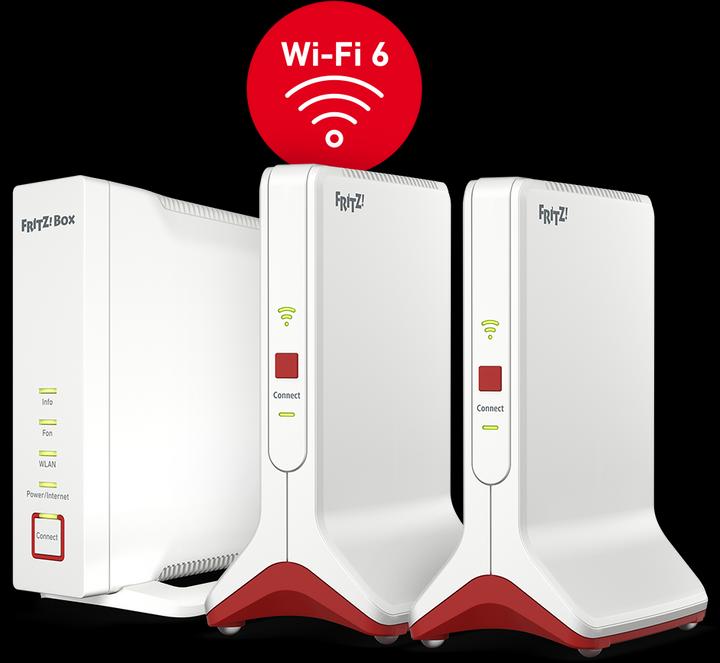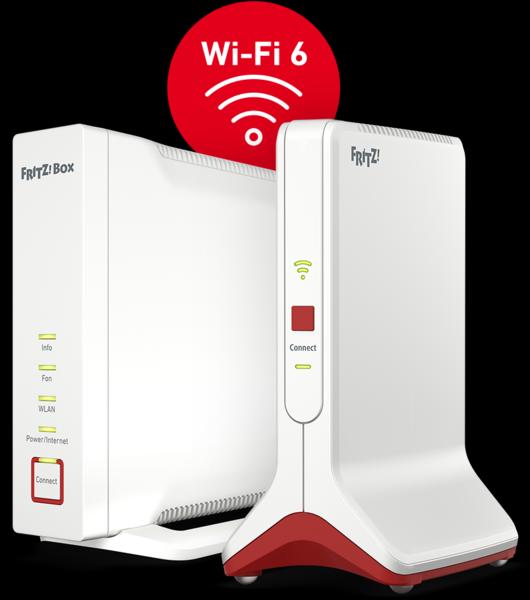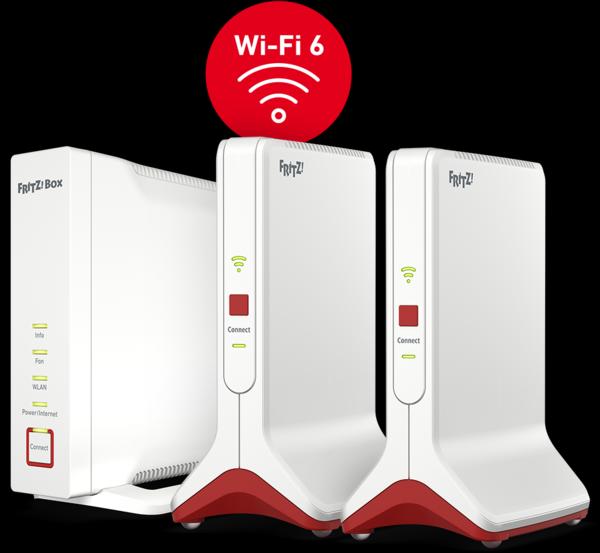

What Wi-Fi 6 brings to the home: Fritzbox 4060 vs. Fritzbox 7490
In theory, Wi-Fi 6 is better than Wi-Fi 5. I'll test whether the change is worth it in practice at my home.
I have a Fritzbox 7490 with Wi-Fi 5 in the middle of my apartment. Three simultaneous video streams in 1080p are no problem. As long as it works, I see no reason to replace it. Still, I'm curious and want to know if the Fritzbox 4060 with Wi-Fi 6 has any advantages while keeping the Internet connection the same.
Wi-Fi 6 vs. Wi-Fi 5: The changes
As a reminder, the two most important innovations of Wi-Fi 6 are the increased maximum data throughput and the better simultaneous coverage of many devices. The highest theoretically achievable data throughput increases with Wi-Fi 6 compared to Wi-Fi 5 from 3.5 to 9.6 gigabits gross per second. In practice, however, an increase of only a factor of 1.4 is expected, since hardly any router with Wi-Fi 5 reaches the theoretical maximum values either.
Wi-Fi 6 is also able to better recognize the necessary bandwidth for different devices and dynamically adjust the channel width. For example, the 4K stream on the TV gets more resources than the smartphone that is only waiting for incoming chat messages.
Wi-Fi 6 is also prepared for the increasing number of devices with WLAN - especially from the smarthome sector - and serves up to eight streams (8x8 MU-MIMO). With Wi-Fi 5, the maximum is four. Wi-Fi 5 can already send data to several devices simultaneously, Wi-Fi 6 can now also receive data from several devices simultaneously. This requires more antennas in the routers and the connected devices - yet Wi-Fi 6 also works with fewer antennas and is also only operated with four in most devices.
There are hardly any differences in terms of security. The encryption standard WPA-3 is now also available for most devices with Wi-Fi 5.
Simple and fast setup
I like how easy it is to set up routers now. Since the Fritzbox 4060 is a WLAN router without a modem, I connect its LAN cable to the WLAN modem. So that the networks don't interfere with each other, I turn off the WLAN of the Fritzbox 7490. The rest of the settings are easily done via the browser under the URL "fritz.box". The necessary access data for the initial login is included on a card.
CH
DE
Measurements
I take the first round of measurements with the Fritzbox 7490 before I connect the Fritzbox 4060. It then gets several days to settle in before I also measure its signal strength, ping and internal download speed.
For signal strength, I use Netspot on the Pixel 6, and I ping my NAS on the router via the Windows console on the Surface Laptop Studio. On it, I also install Totusoft's LAN Speed Test and have one gigabyte of data written and read on the NAS at a time. For my curiosity, I also copy a 5.2 gigabyte file from the NAS to the notebook and manually stop the time.

Since the readings look good everywhere in the apartment and the WLAN doesn't reach its limits, I search for them. I found them under four concrete ceilings in the basement and at the ping-pong table on the playground next door. My WLAN is sufficient up to this point.
Signal strength
The signal strength is measured in decibels milliwatts (dBm). Higher values are better. Very good values correspond to -35 to -50 dBm - good ones to -60 dBm, whereby it becomes critical for many devices from -70 dBm.
| Fritzbox 4060
(2,4 / 5 GHz) | Fritzbox 7490
(2,4 / 5 GHz) | |
|---|---|---|
| Wohnzimmer | -63 dBm / -56 dBm | -65 dBm / -61 dBm |
| Schlafzimmer | -55 dBm / -55 dBm | -53 dBm / -52 dBm |
| Kinderzimmer | -58 dBm/ -54 dBm | -45 dBm / -41 dBm |
| Küche | -53 dBm / -52 dBm | -46 dBm / -44 dBm |
| Keller | -67 dBm / -89 dBm | -78 dBm / -87 dBm |
| Tischtennisplatte | -74 dBm / -88 dBm | -78 dBm / -88 dBm |
At first glance, the signal strength is not an argument for Wi-Fi 6 with the same number of antennas (4x4 MU-MIMO). The Fritzbox 4060 only has a higher signal strength at half of the measuring points - and that only slightly. But at least it performs better at the most distant points. The worse rates - which are still within a usable range - can be tolerated within the apartment. However, it is unclear whether the longer distance is due to Wi-Fi 6. It could also be due to a different antenna design.
It is also noticeable that the 5 GHz band is stronger indoors and the smartphone's first choice. In the basement and at the ping-pong table, the signal of the 2.4 GHz band is better. This coincides with the fact that 5 GHz also offers more data throughput in theory, but less distance compared to 2.4 GHz.
Ping NAS
The ping is specified in milliseconds. It shows how long it takes to send a data packet from the notebook to the NAS and to receive a response packet. The NAS is connected to the router with the network cable.
| Fritzbox 4060 | Fritzbox 7490 | |
|---|---|---|
| Wohnzimmer | 3 ms | 5 ms |
| Schlafzimmer | 4 ms | 3 ms |
| Kinderzimmer | 3 ms | 3 ms |
| Küche | 4 ms | 4 ms |
| Keller | 7 ms | 5 ms |
| Tischtennisplatte | 12 ms | 3 ms |
The ping to the NAS also does not reveal any clear advantages of Wi-Fi 6 in the apartment. The response time even increases - sometimes significantly - at the more distant measuring points. That does not look convincing.

Download speed from NAS
When downloading from the NAS, I determine the average possible number of megabits when downloading a gigabyte-sized file. Eight megabits correspond to one megabyte. In the basement and at the ping pong table, I reduced the packet size to 100 megabytes for the LAN speed test. My patience was not enough for more. To the Fritzbox 7490 with Wi-Fi 5, no usable connection was established at the ping pong table.
| Fritzbox 4060 | Fritzbox 7490 | |
|---|---|---|
| Wohnzimmer | 433 Mbps | 357 Mbps |
| Schlafzimmer | 655 Mbps | 437 Mbps |
| Kinderzimmer | 564 Mbps | 382 Mbps |
| Küche | 624 Mbps | 408 Mbps |
| Keller | 40 Mbps | 88 Mbps |
| Tischtennisplatte | 14 Mbps | Keine stabile Verbindung |
I also copied a 5.2 gigabyte file from the NAS and stopped the time by hand. Depending on the room, the download time improved from a maximum of 117 seconds to a maximum of 63 seconds. The improvement per room was between 62 and 37 seconds.
Finally I see an added value. Data transfers within the network are significantly faster. However, colleague Martin Jud dashes my hopes that Wi-Fi 6 alone must be the reason for this. The router's antennas, the chip and its working memory also play a role. In his tests, he has already come across Wi-Fi 5 routers that outshine Wi-Fi 6 routers with the same or a larger number of antennas.
For downloads from the Internet, however, your Internet connection and the respective download server also come into play as factors. No real improvement can be seen at the outer measuring points - even though nothing worked at all at the ping-pong table with Wi-Fi 5.
Conclusion: No reason to change a running system
As long as the existing router is still running satisfactorily with Wi-Fi 5, there is no reason to change. The advantages of Wi-Fi 6 are very theoretical and only apply to certain scenarios. A simple rented apartment with a centrally positioned router is not one of them.
A large flat-sharing community with ten people and their devices could be a different story. However, a single router is unlikely to cover the area. At least, Wi-Fi 6 did not provide a larger range in my test. For that, the only option is to use repeaters or access points.
Should my current router suddenly give up the ghost, I would go for a model with Wi-Fi 6 when buying a new one, despite my disappointing measurements. With Wi-Fi 6E, the selection is still very small and expensive - and the final standardization of Wi-Fi 7 (aka IEEE 802.11be) is not expected until 2024, and products with it will not come until after that.
Overall, Wi-Fi 6 is an investment in the future that doesn't necessarily pay off immediately yet. In order for the standard to show its advantages, such as dynamic channel width, all end devices in the network must be able to handle it, and even your neighbors' routers.
Martin Jud tested the Fritzbox 4060 in combination with the FritzRepeater 6000. You can read about how it compares to other mesh systems here:
When I was but a young student, I'd sit in my friend's living room with all my classmates and play on his SuperNES. Since then I've had the opportunity to test out all the newest technology for you. I've done reviews at Curved, Computer Bild and Netzwelt, and have now arrived at Galaxus.de.








